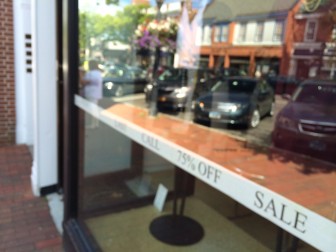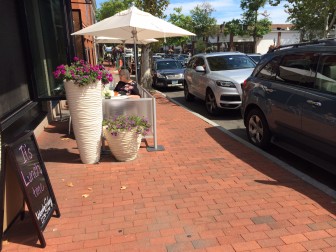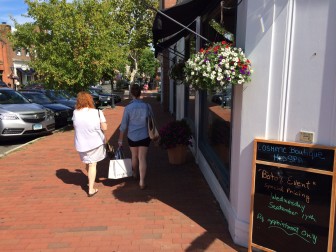Saying that too much and certain types of signage in the downtown are unseemly, New Canaan planning officials are turning their attention to a problem that they say ultimately affects overall property values.

Here’s a sign taped inside the window of a shop on Elm Street. Credit: Michael Dinan
The three major problems with signs in New Canaan’s business district are sandwich boards, pasted notices on windows and ‘For Sale’ signs, Laszlo Papp, chairman of the Planning and Zoning Commission, said at the group’s Aug. 26 meeting.
Papp said P&Z would appoint a task force to take up the matter, and that he would include merchant groups such as the New Canaan Chamber of Commerce “so that it would be obvious that controlling signage does not mean the commission would intend to harm or curtail the merchants in town.”

A sandwich board on an Elm Street sidewalk. Credit: Michael Dinan
“The significance is the quality of the downtown—that is the issue,” Papp said at the meeting, held in the Douglas Room at Lapham Community Center. “And the quality of the downtown is an issue for overall town property values. Because the property values of every house, to a great extent, are supported by the quality of the town center and its appearance. So a small thing like a sign snowballs into a much bigger issue.”
P&Z Commissioner David Scannell said that the problem of signs goes beyond the downtown, and that groups that adhere to the rules (which are here, see Section 6.3) often are dismayed when it appears that those rules aren’t enforced by others. Commission Secretary Jean Grzelecki said improper roadside signs often are left by out-of-towners.
For the business district, New Canaan’s Zoning Regulations Section 6.3.F list of prohibitions includes the following language:
- “Sandwich Board and easel type signs.”
- “In any Retail Zone or any Business Zone, no sign shall be located forward of the building or setback line.”
- “No sign shall contain a logo which is recognized as a company or entity’s trademark.”
Papp said the problem is a combination of regulating the signage itself and then enforcing the regulations.

A sandwich board outside a shop on Elm Street. Credit: Michael Dinan
Asked for her thoughts on the matter in an interview after the meeting, Chamber Executive Director Tucker Murphy said that there’s an ongoing push and pull, where P&Z “has bent over backwards” to support downtown merchants’ needs, but often sees a few businesses overstep.
“What P&Z has tried to do with my help is come up with a balance so that we don’t get out of control, but the businesses need all the help that they can get,” Murphy said.
One example of P&Z’s ability to embrace the downtown as a whole, Murphy said, are the planters that businesses such as Earth Garden and Geiger’s create and maintain downtown. Those businesses at first were breaking rules by placing cards with their company information and logos in the planters themselves, but P&Z ultimately saw the greater aesthetic benefit to the downtown and created rules about the size and types of the cards themselves.
“The merchants need an opportunity to get their business message across, but P&Z has worked with them to the best of their ability,” Murphy said.
I want to receive emails regarding New Canaan news -how do I get on the lsit?
Hi Vince — you can sign up right here and they’ll come starting the next morning http://newcanaanite.us3.list-manage2.com/subscribe?u=34e07453b5afd6e7c77e3c80c&id=dce7b5b118